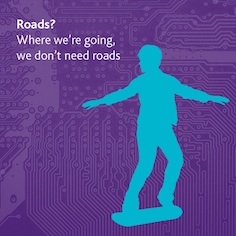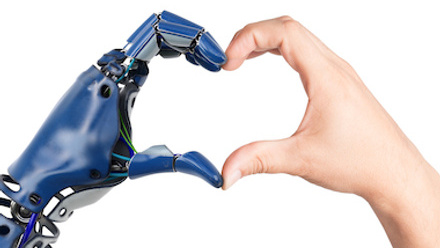Roads? Where we're going, we don't need roads
We are here, now, and one thing that has grabbed our attention is to see how accurate some of the predictions were…
Surprisingly accurate! Video communication in Back To The Future II looks a lot like Skype and FaceTime.
Video glasses are very similar in concept to Google Glass and wearable tech.
Flat screen TVs mounted on walls in Back To The Future II have started to appear in family homes. The hands-free video arcade game is now around with Xbox Kinect and PlayStation Eye.
Even fingerprint technology is around in 2015, even if it’s not in wide use.
We have also seen Hendo Cover develop the closest thing to a hoverboard.

We’re not there yet with flying cars, but with the pace that technology moves it can’t be beyond the realms of possibility that this will be with us one day.
We can’t dismiss anything and what was seen as futuristic technology 25 years ago is actually fairly normal now.
2015 has now seen driverless cars trialled through the streets of Greenwich, Bristol, Coventry and Milton Keynes.
But even the visionaries of Back To The Future II didn’t envisage the emergence of mobile phones and the internet as ways of communicating; plus it’s not unkind to say that it oversold the popularity of fax machines.
Technology is part of our lives, in almost everything we do. And technology will continue to be a part of our lives, in ways we have yet to dream of.
Technology needs to service our needs and demands right now, as well as thinking “what’s next?”
Expectations in 2015 are infinitely higher than what they would have been even five years ago.
Real time access to technology and communicating across large communities no matter where in the world is seen by most as a given.
Anything else can feel slow and if things take too long to action we lose focus quickly and move onto something that meets our needs.
People know they can do things quickly through the likes of Amazon and Twitter and so why wouldn’t they expect that to be the case with their employee benefits too.
In the employee benefits space we are seeing growing consumerism thanks in large parts to these advancements in technology.
Improvements in technology means that people are able to work flexibly, whether this is working from home more often, accessing email out of the office or changing work patterns.
The things we see in our home life we now expect in our work lives.
It is up to those lagging behind to catch up rather than forcing people to adjust their expectations.
It just doesn’t work that way.
Technology is there to fit into our lives.
When we look at data from our own employee benefits portal, Orbit, we can see that of the near one million logins over the last year, 1,550 employees were accessing the site at 4am.
Now these people could be thinking about childcare vouchers in the middle of the night or they may be accessing their account from Malaysia.
The point is that Orbit needed to be open during these unsociable hours.
Also 33,445 employees have signed up to receive alerts by email or SMS on their pension funds – people want to be informed about their pension in real time rather than having to physically log on and check.
We continue to explore the different ways technology can help people to connect with, and understand their benefits.
This is a relentless pursuit but absolutely vital in employee engagement with pensions and benefits.
People accessing their benefits at 4am kind of shows that people never sleep.
So the portal to support them can’t sleep either. And as technology continues to blow our minds, shifting and turning at breakneck speeds, we too have to adapt and grow.
There are limits, of course, but we can’t make technology the limit.
People will always have ideas.
Perhaps what really holds technology back are things like public perception (do we really want this?), economics (is this affordable?) and, of course, our own imaginations.
This article was supplied by Gareth Davies, research manager, Capita.
In partnership with Capita Employee Solutions
UK leader in technology-enabled business process management and outsourcing solutions.







